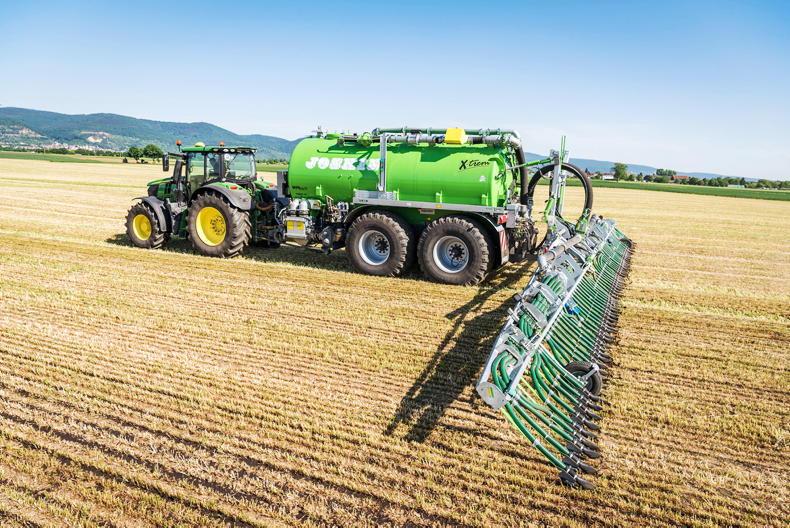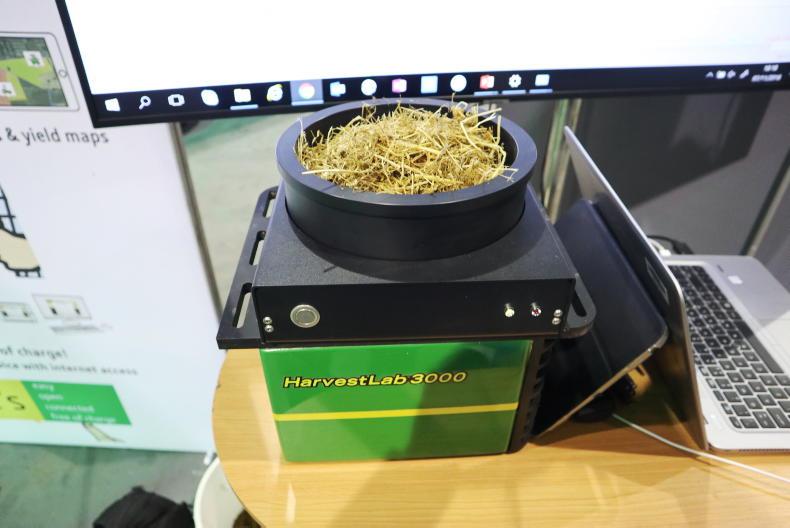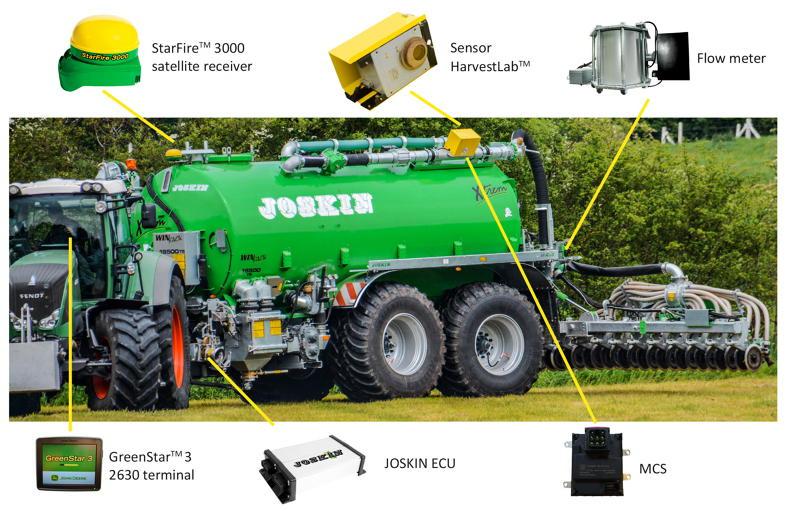On some farms slurry is still seen as a waste that needs to be emptied from the slatted tank, rather than a product that could benefit the land. But the nutrient content of slurry is becoming a bigger factor in decisions about spreading.
Slurry nutrients, if correctly used, will replace purchased fertiliser, but if they are not captured efficiently they can contribute to air pollution, greenhouse gas emissions and water pollution.
Low-emission slurry spreading (LESS) equipment such as trailing shoe spreaders or dribble bars can improve the efficiency of nutrient use. Legislation, TAMS grants and farmer awareness of their benefits are increasing adoption rates.
The use of macerators/distributors and multiple spreading outlets on LESS units usually brings the bonus of more even application across the width of spread. But when slurry nutrient content varies, this does not ensure that the nutrients are applied evenly.
Variation in slurry nutrient content
There are many factors which influence slurry nutrient content. The animal species that produces the slurry has a big impact, with cattle slurry for example having half of the available N compared to pig slurry, but about 50% more P and K.
But there is also a big variation in nutrient content within particular types of slurry. In a Teagasc survey, the variation in nutrient content in cattle slurry (Table 1) was huge, mainly driven by dry matter varying from 0.4% to almost 12%.
Water getting into slurry systems is a big factor. Even if the lowest dry matter slurry values were excluded, some slurries can have twice or three times the nutrient content of others. With cattle systems, most of this is caused by variations in water content. But other factors can have an impact. The effectiveness of agitation, the feeding system used (pigs), and even the type of feed, can all affect nutrient content.
Testing slurry nutrient content
To apply slurry nutrients accurately, we need to know what the nutrient content is. Samples of slurry can be taken and sent for laboratory analysis, but this requires a representative sample to be taken; so full agitation is necessary and separate slurry stores would need to be sampled separately.
Once the nutrient content is known, the application rate can be adjusted, or where the spreading is completed before you have analysis results, the rates of any balancing fertiliser can be adjusted. But very few people analyse their slurry. A cheaper option is to use a simple hydrometer (which accurately measures density) to measure the dry matter of the slurry, but again this system requires a well-agitated sample of representative slurry and the estimated nutrient content to be read from a chart.
On-tanker nutrient measurement
Being able to directly measure nutrient content in-line on the slurry tanker brings many benefits, including simplicity, speed, convenience and the ability to automatically control the application of nutrients. The need for representative slurry sampling is eliminated.
Teagasc researchers (JJ Lenehan and Des Keppel) were part of one of the first teams to work on nutrient sensing on tankers in the 1990s, when an array of sensors were evaluated on a research tanker. While the results were promising, commercial development was needed to make this feasible on tankers. Now that process has happened and today the sensing system that is most available is NIR (near infra-red reflectance sensing), but NMR (nuclear magnetic resonance) is being touted as a future alternative. 
Being able to directly measure nutrient content on the tanker gives the ability to automatically control nutrient application.
NIR slurry nutrient sensors
NIR technology has been around for many years and has been used to assess crop characteristics since the 1970s. In simple terms, when any biological material is exposed to certain wavelengths from the electromagnetic spectrum (light mostly), its tendency to absorb and reflect certain wavelengths gives a characteristic signature of that material.
In agriculture, NIR sensing is used to assess crop growth and nitrogen content in fields and has been used in laboratories for feed analysis, including silage analysis, for years.
John Deere was one of the first companies to mount an NIR sensor (manufactured by Zeiss) on a forage harvester (Harvest Lab) to assess the dry matter and feeding value of the forage as it is being harvested.
Today, this type of technology from John Deere and many others (eg ZunHammer, Evo NIR etc) is available for measuring slurry nutrients in the slurry flow on a tanker and is offered by a range of slurry tanker manufacturers, including Irish companies.
Does NIR work?
NIR can accurately predict N, P and K content along with dry matter, but its accuracy, as with all NIR applications, is dependent on the availability of suitable calibration sets. If the sensor is presented with a slurry type that is not within its calibration set, then the reliability of its measurement may not be high.
To be effective, an NIR system must have a good sensor, an installation that is robust and exposes the sensor correctly to the slurry, a good instrument to control the sensor and, most of all, robust calibrations.
This requires a considerable investment by the developing company. Interestingly, the same basic NIR unit (eg John Deere Harvest lab) can be used on a forage harvester, on a slurry tanker or on a lab bench, provided the calibrations are available. 
NIR technology has been around since the 70s for the assessment of crops via particular light wavelengths.
NMR: different technology!
A sensor based on nuclear magnetic resonance technology, being developed by NanoNord in conjunction with Aarhus University in Denmark, was shown at Agritechnica in 2019.
This is a scaled-down version of the MRI technology used in medicine, but used in a very different way. It can detect slurry constituents at an atomic level and, once calibrated by the manufacturer for the individual elements, it should not need a range of calibration curves like NIR does.
While the technology can currently measure slurry nutrient content in the lab, the technology is being developed and trialled for field use on tankers. Slurry equipment manufacturer Samson is currently working with the developers of this system.
Sensors and application control
Knowing the nutrient content of the slurry is one thing, but how is the application rate of the nutrients then controlled? This will depend on the specification of the tanker and other measuring equipment on it. Most systems use a slurry flow meter on the tanker which in conjunction with forward speed measurement can then determine the application rate in litres or m³/ha. Once the nutrient content of the slurry is known, then the application rate of N, P and K is known. But this technology allows full control systems to be implemented.
If the tanker is fitted with a variable speed fixed displacement pump, then application rate can be varied by controlling the pump speed. Where certain compatible tractors are used, the controller can automatically control the speed of the tractor by controlling its transmission to ensure the correct nutrient application rate is achieved.
To control the application rate, the operator usually has a choice of selecting a desired rate of nutrient (for example nitrogen) on the in-cab control unit, but also to set maximum levels of other nutrients (eg P). The controller will then control the application rate to put the correct level of the target nutrient out, but if variation in nutrient content threatens overdosing of a nutrient with a max threshold, the controller will automatically reduce the application rate.
If a GPS-enabled controller is used, an application map recording the nutrient application rate to the different parts of the field is stored. This can be used to generate application maps for a GPS-controlled fertiliser spreader to balance the nutrients applied in a follow-up application.
If using a GPS enabled controller an application map recording the nutrient application rate to the different parts of the field is stored.
Can we afford this
technology?
Nutrient sensors, slurry flow sensors, controllers and variable speed pumps all add up to a considerable expense, easily adding €30,000+ to the price of a tanker.
With time, technology may become less expensive, but today, only those with scale (ie those with very large amounts of precise work to be done) could justify it.
So is precise application of slurry nutrients going to be the preserve of a few? Not at all. Accurate slurry application can be achieved by following these steps:
Use a hydrometer to estimate the dry matter of a well agitated sample of slurry and reading off its nutrient content using Irish slurry values (available from Teagasc).Develop a constant driving and application technique and measure the time taken to spread a known quantity of slurry to estimate a discharge rate.With a known nutrient content and discharge rate, calculate the forward speed required to give the required application rate.Always record the rate applied to each field and calculate the subsequent quantity of fertiliser to achieve the target applied rates.
On some farms slurry is still seen as a waste that needs to be emptied from the slatted tank, rather than a product that could benefit the land. But the nutrient content of slurry is becoming a bigger factor in decisions about spreading.
Slurry nutrients, if correctly used, will replace purchased fertiliser, but if they are not captured efficiently they can contribute to air pollution, greenhouse gas emissions and water pollution.
Low-emission slurry spreading (LESS) equipment such as trailing shoe spreaders or dribble bars can improve the efficiency of nutrient use. Legislation, TAMS grants and farmer awareness of their benefits are increasing adoption rates.
The use of macerators/distributors and multiple spreading outlets on LESS units usually brings the bonus of more even application across the width of spread. But when slurry nutrient content varies, this does not ensure that the nutrients are applied evenly.
Variation in slurry nutrient content
There are many factors which influence slurry nutrient content. The animal species that produces the slurry has a big impact, with cattle slurry for example having half of the available N compared to pig slurry, but about 50% more P and K.
But there is also a big variation in nutrient content within particular types of slurry. In a Teagasc survey, the variation in nutrient content in cattle slurry (Table 1) was huge, mainly driven by dry matter varying from 0.4% to almost 12%.
Water getting into slurry systems is a big factor. Even if the lowest dry matter slurry values were excluded, some slurries can have twice or three times the nutrient content of others. With cattle systems, most of this is caused by variations in water content. But other factors can have an impact. The effectiveness of agitation, the feeding system used (pigs), and even the type of feed, can all affect nutrient content.
Testing slurry nutrient content
To apply slurry nutrients accurately, we need to know what the nutrient content is. Samples of slurry can be taken and sent for laboratory analysis, but this requires a representative sample to be taken; so full agitation is necessary and separate slurry stores would need to be sampled separately.
Once the nutrient content is known, the application rate can be adjusted, or where the spreading is completed before you have analysis results, the rates of any balancing fertiliser can be adjusted. But very few people analyse their slurry. A cheaper option is to use a simple hydrometer (which accurately measures density) to measure the dry matter of the slurry, but again this system requires a well-agitated sample of representative slurry and the estimated nutrient content to be read from a chart.
On-tanker nutrient measurement
Being able to directly measure nutrient content in-line on the slurry tanker brings many benefits, including simplicity, speed, convenience and the ability to automatically control the application of nutrients. The need for representative slurry sampling is eliminated.
Teagasc researchers (JJ Lenehan and Des Keppel) were part of one of the first teams to work on nutrient sensing on tankers in the 1990s, when an array of sensors were evaluated on a research tanker. While the results were promising, commercial development was needed to make this feasible on tankers. Now that process has happened and today the sensing system that is most available is NIR (near infra-red reflectance sensing), but NMR (nuclear magnetic resonance) is being touted as a future alternative. 
Being able to directly measure nutrient content on the tanker gives the ability to automatically control nutrient application.
NIR slurry nutrient sensors
NIR technology has been around for many years and has been used to assess crop characteristics since the 1970s. In simple terms, when any biological material is exposed to certain wavelengths from the electromagnetic spectrum (light mostly), its tendency to absorb and reflect certain wavelengths gives a characteristic signature of that material.
In agriculture, NIR sensing is used to assess crop growth and nitrogen content in fields and has been used in laboratories for feed analysis, including silage analysis, for years.
John Deere was one of the first companies to mount an NIR sensor (manufactured by Zeiss) on a forage harvester (Harvest Lab) to assess the dry matter and feeding value of the forage as it is being harvested.
Today, this type of technology from John Deere and many others (eg ZunHammer, Evo NIR etc) is available for measuring slurry nutrients in the slurry flow on a tanker and is offered by a range of slurry tanker manufacturers, including Irish companies.
Does NIR work?
NIR can accurately predict N, P and K content along with dry matter, but its accuracy, as with all NIR applications, is dependent on the availability of suitable calibration sets. If the sensor is presented with a slurry type that is not within its calibration set, then the reliability of its measurement may not be high.
To be effective, an NIR system must have a good sensor, an installation that is robust and exposes the sensor correctly to the slurry, a good instrument to control the sensor and, most of all, robust calibrations.
This requires a considerable investment by the developing company. Interestingly, the same basic NIR unit (eg John Deere Harvest lab) can be used on a forage harvester, on a slurry tanker or on a lab bench, provided the calibrations are available. 
NIR technology has been around since the 70s for the assessment of crops via particular light wavelengths.
NMR: different technology!
A sensor based on nuclear magnetic resonance technology, being developed by NanoNord in conjunction with Aarhus University in Denmark, was shown at Agritechnica in 2019.
This is a scaled-down version of the MRI technology used in medicine, but used in a very different way. It can detect slurry constituents at an atomic level and, once calibrated by the manufacturer for the individual elements, it should not need a range of calibration curves like NIR does.
While the technology can currently measure slurry nutrient content in the lab, the technology is being developed and trialled for field use on tankers. Slurry equipment manufacturer Samson is currently working with the developers of this system.
Sensors and application control
Knowing the nutrient content of the slurry is one thing, but how is the application rate of the nutrients then controlled? This will depend on the specification of the tanker and other measuring equipment on it. Most systems use a slurry flow meter on the tanker which in conjunction with forward speed measurement can then determine the application rate in litres or m³/ha. Once the nutrient content of the slurry is known, then the application rate of N, P and K is known. But this technology allows full control systems to be implemented.
If the tanker is fitted with a variable speed fixed displacement pump, then application rate can be varied by controlling the pump speed. Where certain compatible tractors are used, the controller can automatically control the speed of the tractor by controlling its transmission to ensure the correct nutrient application rate is achieved.
To control the application rate, the operator usually has a choice of selecting a desired rate of nutrient (for example nitrogen) on the in-cab control unit, but also to set maximum levels of other nutrients (eg P). The controller will then control the application rate to put the correct level of the target nutrient out, but if variation in nutrient content threatens overdosing of a nutrient with a max threshold, the controller will automatically reduce the application rate.
If a GPS-enabled controller is used, an application map recording the nutrient application rate to the different parts of the field is stored. This can be used to generate application maps for a GPS-controlled fertiliser spreader to balance the nutrients applied in a follow-up application.
If using a GPS enabled controller an application map recording the nutrient application rate to the different parts of the field is stored.
Can we afford this
technology?
Nutrient sensors, slurry flow sensors, controllers and variable speed pumps all add up to a considerable expense, easily adding €30,000+ to the price of a tanker.
With time, technology may become less expensive, but today, only those with scale (ie those with very large amounts of precise work to be done) could justify it.
So is precise application of slurry nutrients going to be the preserve of a few? Not at all. Accurate slurry application can be achieved by following these steps:
Use a hydrometer to estimate the dry matter of a well agitated sample of slurry and reading off its nutrient content using Irish slurry values (available from Teagasc).Develop a constant driving and application technique and measure the time taken to spread a known quantity of slurry to estimate a discharge rate.With a known nutrient content and discharge rate, calculate the forward speed required to give the required application rate.Always record the rate applied to each field and calculate the subsequent quantity of fertiliser to achieve the target applied rates. 








 This is a subscriber-only article
This is a subscriber-only article











SHARING OPTIONS: